|
|

He's fine. Your dad has been knocked unconscious probably a thousand times by now.
The Meitantei Conan anime (localized as Detective Conan and Case Closed) has been running since January 1996. I didn't start watching it until much later than that, but I have been following it for something like 13 years. I did start from the first episode, but I ended up I skipped hundreds of episodes in what was at the time the middle of its run. Still, I've basically seen all of the episodes from the past decade at least, including a number of spinoffs. It's getting to be entirely too many because I'm tired of the anime-original episodes.
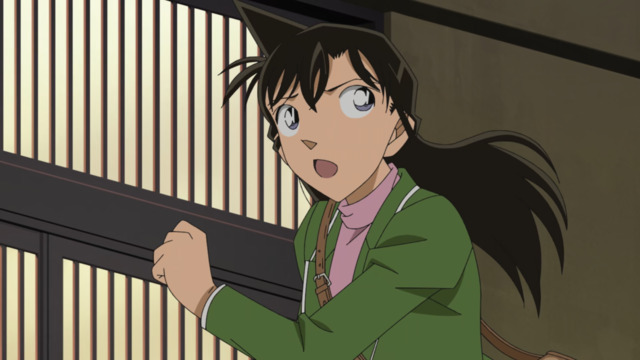
On the plus side, Ran will probably kick some guy in the neck next episode.
I've complained about this before, but now I've decided to stop watching the series aside from the episodes that draw from the source material. Thankfully, the Japanese-language Wikipedia entry gets updated in a timely fashion, making it easy to identify which episodes to pass up. It's not that there aren't good anime-original episodes, but there are entirely too many that don't seem worth watching when a show has run as long as Detective Conan. Incidentally, the plot episodes based on the manga do suggest the main story is getting somewhere, but I have no idea if that means a conclusion is looming, or if we'll still be in basically the same place a decade from now.
Posted in Detective Conan | Tags: All-Time Babes, Detectives, Dropped Shows, Hair, Legs that go up to her neck, Megumi Hayashibara, Season Introduction, Shows that never end, Winter 2023 | Permanent Link

Nice hat.
Cold War PseudoSoviets sending a vampire into space is an interesting enough premise that I would give Tsuki to Laika to Nosferatu (localized as either Moon, Laika, and the Bloodsucking Princess or Irina: The Vampire Cosmonaut) a chance on general principle. Having Hayashibara Megumi voice the lead role seals it. (She's had plenty of lead roles, but this is much less common these days.) Giving it an OP by ALI PROJECT is also a bonus.
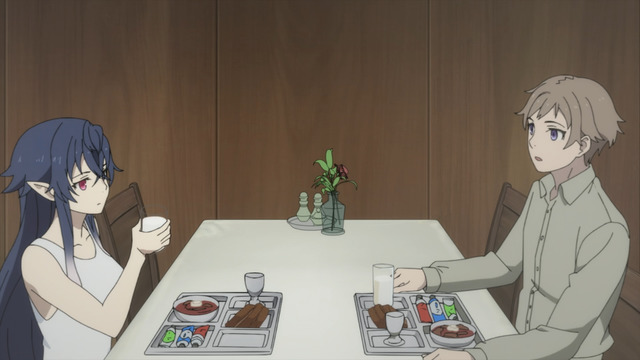
The tubes contain cosmonaut food. I wonder if there is also CMYK cosmonaut food.
I like that Tsuki to Laika to Nosferatu rejects most of the typical vampire lore. Irina is also not physically superior to the human candidates by some unreachable degree. She is better, since she can nearly keep up—despite an utter lack of any prior training—with the human candidate who had been working for some time toward becoming the first cosmonaut before becoming her trainer.
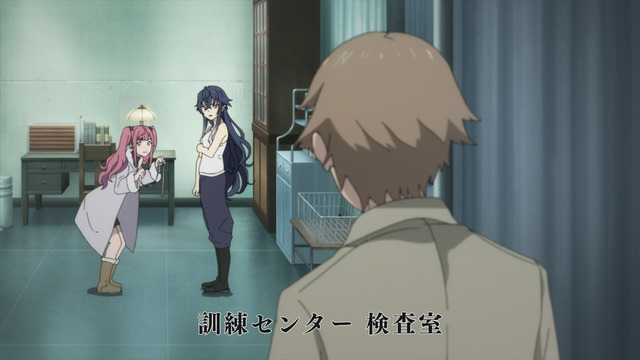
Anya measured Irina's blood pressure, and she can bleed, so I guess she's not undead.
I originally assumed the NotSoviets wanted a vampire cosmonaut because of their inherent survivability or reduced need for life-support systems, but it turns out it has more to do with how vampires are regarded in that world as a sub-human race. Therefore, they are test subjects treated as expendable and useful to a nascent space program sort of the way dogs and monkeys are.
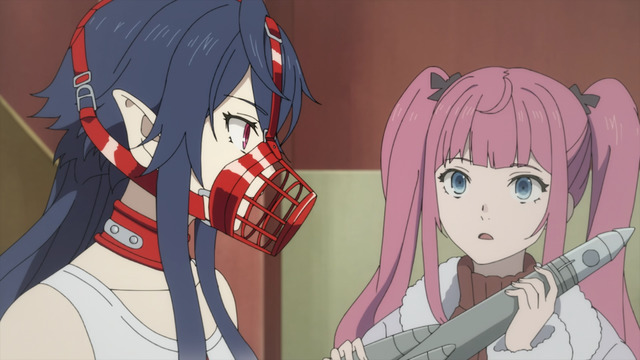
She's wearing the muzzle because of racism.
There are some light-novel elements in the series that hold it back to some degree (minor tsundere dishonesty, some jerkface assholes, stuff like that), but nothing that significantly detracts from my overall enjoyment of the show so far. I'm hoping we can avoid a vampires-are-people-too arc, but that's probably inevitable considering our vampire cosmonaut is a 43-kilogram girl who hides vulnerable emotions and not, y'know, Alucard from Hellsing.
Posted in Tsuki to Laika to Nosferatu | Tags: Ali Project, Autumn 2021, General Principle, Initial impressions, Light Novels, Megumi Hayashibara, OP ED, Season Introduction, tsundere, Vampires | Permanent Link
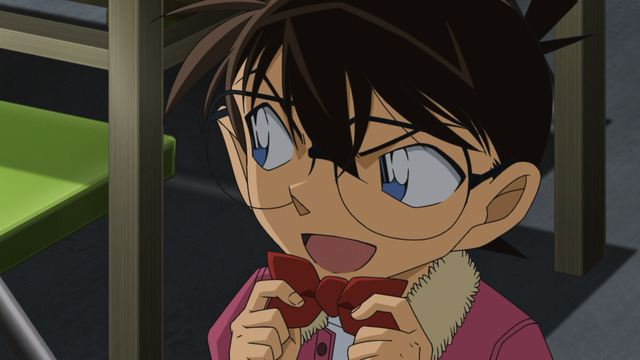
Well, this hasn't changed at all.
Surprising almost one one, I'm sure, there are not a lot of plot-specific episodes of Detective Conan. Rather, there are probably readers who may be legitimately surprised to hear that Detective Conan even has a plot. Even though most episodes of the show do not feature any continuity, the anime-original ones are notably inferior to the non-plot-specific episodes that at least still derive from the source manga. I can usually tell when an episode is an anime original, mostly because the mystery's contrivances will be stupid instead of merely silly, and oftentimes characters will do something perplexing simply because the action more easily advances the story from point A to point B. Basically, I'll be watching an episode, and something will happen to make me think it's an anime-original one, and when I check later it will turn out I was right. In fact, I'm not sure I've been wrong yet.
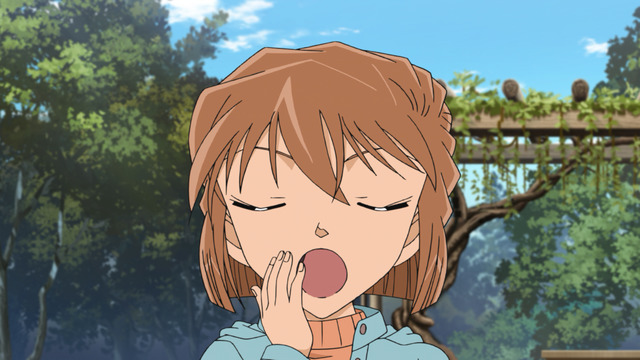
I'm pretty happy Hayashibara Megumi continues to have regular appearances, even if Ai seems sort of bored.
Having a greater ratio of anime-original episodes in Detective Conan now is perfectly understandable, seeing as how the anime has nearly exhausted the available cases from the source manga by this point. One of the secondary impacts, though, is that this means I can no longer reliably use Detective Conan as my control. For those of you who have no idea what I'm talking about, I started rating shows by episode as a goof years ago, but then the chart kept growing and now it's just one of those things I guess I'm going to continue doing indefinitely. But I also can't assume that my rating standards will remain consistent from season to season and year to year. Hence, I used Detective Conan as my control, theorizing that I could count on such a long-running show to remain pretty much as good as it ever was. Therefore, how much better or worse another show's rating is relative to the average Detective Conan score for the same time period would offer a reliable check on quality beyond the numerical scores themselves. This is probably no longer the case if there are more anime-original episodes of Detective Conan now, and assuming the anime-original episodes are not as good. I guess I'm going to need to come up with some other form of sham metric now. Alas.
Posted in Detective Conan | Tags: Autumn 2019, Detectives, Megumi Hayashibara, Mysteries, Shows that never end | Permanent Link

At least there's no spinning watermark.
Although I own all the DVDs, I chose to re-watch my archive of Love Hina fansubs over the past few months. As you might expect, the video and audio quality is atrocious by modern standards, with 320x240 15fps encodes being the norm. (The entire season fits on two CD-Rs.) Depending on the group, the subtitles themselves can also be quite poor by today's standards. Many lines are poorly timed and some episodes were clearly finished by non-native English speakers. Every single episode was generally inferior from a technical perspective than the samples in my recent Chu-Bra!! PSP experiment. Nevertheless, Love Hina in this crude form invokes a certain nostalgia when remembering the brief, recent history of anime distribution in America.
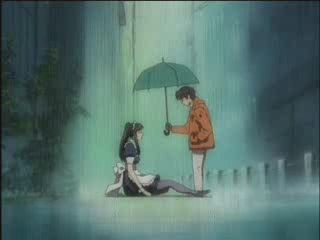
Try a little tenderness, Keitaro.
Love Hina was one of the first shows successfully distributed widely in entirely digital formats. Although the initial rips came from analog broadcasts, the Internet (and sneakernet) distribution of Love Hina episodes was accomplished digitally. Heretofore, American anime fans typically purchased, traded, or copied videotapes of fansubs. This is how I first watched All Purpose Cultural Cat Girl Nuku Nuku, for example. For those unfamiliar with the medium, videotapes are purely analog, so the quality degrades significantly after each generation. If you were lucky, you got to watch something that was low enough on the copy-of-a-copy-of-a-copy chain that it did not look like mush.

Aneue > Onee-sama.
What a long way we've come in merely a decade. Fansubs today appear with soft-subs that can be turned off and video quality that surpasses DVD limitations by a large margin. No wonder the anime DVD bubble collapsed so quickly. I, like many buyers, contracted my buying habits once DVDs became clearly inferior to recordings of initial broadcasts—waiting for Blu-ray releases. I'm still waiting. FUNimation is taking cautious steps, but I won't be cajoled long by lackluster upscales.
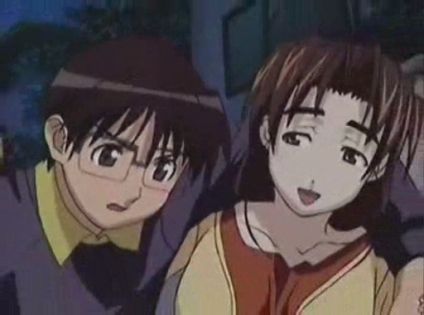
Keitaro's dilemma at the end of Love Hina is not
unlike Shinji's struggle with Instrumentality.
So what about Love Hina itself? Many former fans have recanted their affection for the title, disclaiming, "I hadn't seen much anime at that time, so I didn't know better." I still find Love Hina as charming and funny as ever. It balances a winning combination of absurd mechanized turtles and emotional resonance. It's a relic from a time of the big-boobed tsundere (before the stereotype turned into a complete joke), to be sure, and its harem comedy roots were unoriginal even then, but its cast remains engaging. Megumi Hayashibara is still absolutely dead-on as Aunt Haruka, and a round or two with Motoko reminds me how sorely Asakawa Yuu is missed. Likewise, the motif about promises still rings true today; it carries more import than the typical canned motivations anime characters generally spout. And perhaps it also implores viewers to remember a past they once loved and should not forget.
Posted in Loot, Love Hina | Tags: Harem Comedy, Hime Cut, History, Megumi Hayashibara, PSP Experiment, Try a Little Tenderness, tsundere, Yui Horie | Permanent Link
I've been re-watching a number of older series lately—among them, Sunrise's 1998 Cowboy Bebop. This show is likely well known by even the casual anime fan, but I figured this would be a good time to revisit the series just so I could better see if the comparisons Coyote Ragtime Show generate are justified.
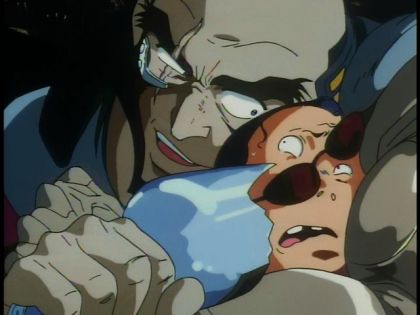
Jet chokes someone out.
After a teaser glimpse of the conclusion of the first arc, the first episode of Cowboy Bebop gets down to business and establishes that the show is set in a future where space travel is completely unremarkable. Automated toll receipts from gate jumps of tremendous distances pile up as common litter, like cigarette butts. Nevertheless, although technology is obvious far advanced beyond the present day, humanity's general standard of living seems no better. Graffiti and trash still plague decaying city streets, and seamy bars still attract criminal lowlifes. And vice.
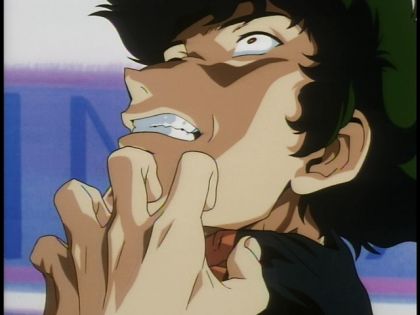
Someone chokes out Spike.
Where Cowboy Bebop triumphs is in its lazy depiction of what it's like to be one of the Good Guys in this decrepit future. Beautiful, melancholy jazz music haunts every episode, punctuated by Spike and Jet's banter, and their occasional angst-less philosophical musings.
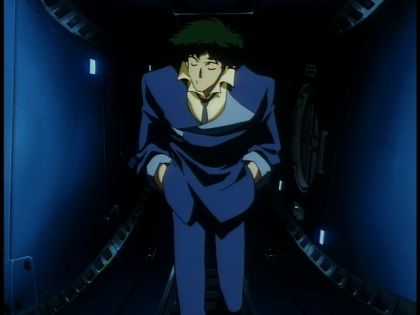
Spike.
The voice acting is quite good, with Kouichi Yamadera still carrying the unperturbed, unflappable coolness (and some smarminess) that he brought to Ryoji Kaji in Neon Genesis Evangelion a few years earlier. Unshou Ishizuka brings a mature wisdom to Jet in a way that, for some reason, I sort of want to call "a Norio Wakamoto without the irony." (I don't know why.)
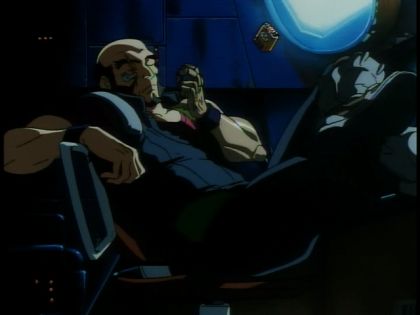
Jet.
I'm also a big fan of Megumi Hayashibara's work as Faye Valentine, but I'll get to her when (read: if) that episode rolls around.
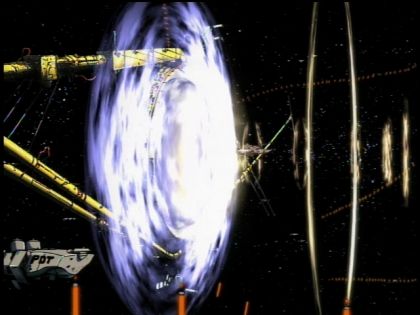
The Bebop exits a gate.
I never liked the CG usage in Cowboy Bebop much, since it doesn't match the rest of the animation well enough in my opinion. Nevertheless, it is pretty good considering the time. It does hold up better than the CG in VanDread, for example.
As far as comparisons with Coyote Ragtime Show go, both series feature sharp bursts of violence unapologetically. At least with regard to the violence in the two shows' first episodes, the violence in Coyote Ragtime Show is a bit more gratuitous. One key stylistic difference stands out, too: Moe. Moe as we know it today wasn't nearly so prevalent in 1998. Coyote Ragtime Show, on the other hand, while not exactly a moe vehicle, certainly is no stranger to the phenomenon.
Posted in Cowboy Bebop | Tags: Megumi Hayashibara, Sunrise | Permanent Link
All Purpose Cultural Cat Girl Nuku Nuku is a lesser known anime that's deserves way more love.
The basic premise of the original six-episode OAV is that scientist-dad has split from his wife and her military hardware family business, making off with their son and scientist-dad's android masterpiece.
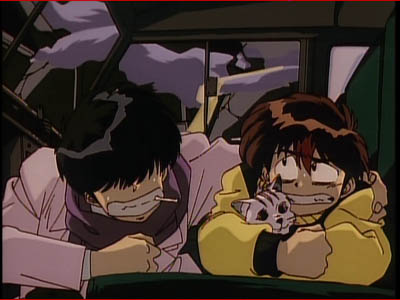
Kyusaku, Ryunouke, and cat
While they're on the lam (actually while taking a piss), the kid adopts a stray cat.
Unfortunately, the cat dies after they're attacked by one of the wife's attack helicopters.
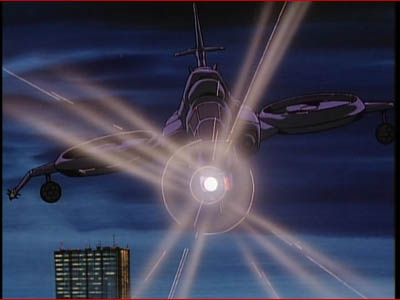
Poison-1
No problem. Scientist dad implants the brain of the cat into the android and pawns the whole package off as a high school girl.
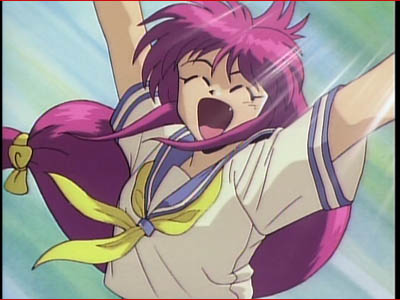
Nuku Nuku
By the way there are plenty of the traditional anime idioms to be found here, such as the waterfall crying, the laughing eyes, and what not, but the anime on a whole does look pretty good.
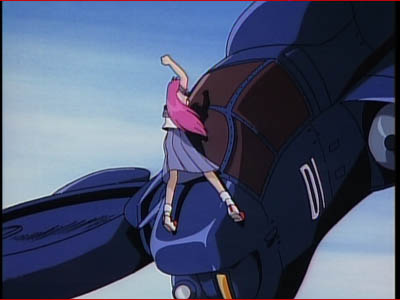
Nuku Nuku pounding on Poison-1
Nuku Nuku takes a stand against the wife and her cronies so she, the boy, and scientist-dad can all live like a normal family.
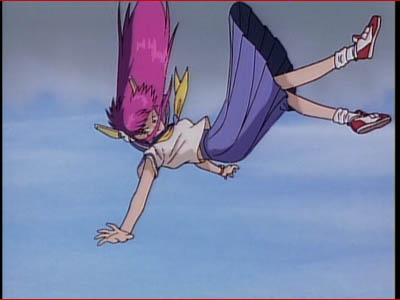
All anime robots girls are required to have these ear-things
There are mecha, and giant robots, and fairly discrete fan service, and did I mention a near-indestructible high school girl robot with the brain of a cat?
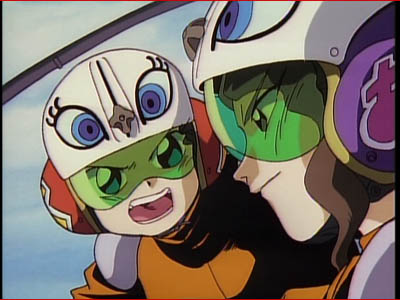
Kyouko and Arisa
Sealing the deal is the the voice acting of Megumi Hayashibara (as Nuku Nuku) and Aya Hisakawa (as Arisa, the more war-mongering of the two henchmen).
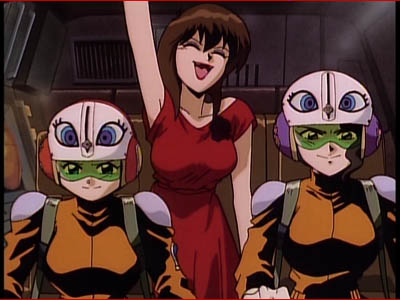
Kyouko, Akiko, and Arisa
Incidentally, the wife's henchmen are fucking cool, and it's not just the killer helmets.
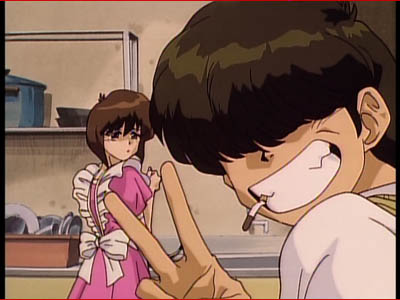
Akiko and Kyusaku
Episode Three features the mom trying to be domestic and traditional a la Aoi from Ai Yori Aoshi. This episode is especially hilarious. If it has any weakness at all it's that the henchmen aren't in it as much.
All six episodes of the first All Purpose Cultural Cat Girl Nuku Nuku OAV are available on one R1 DVD by ADV. There are some shitty fansubs floating around, and I do know a DVD rip was posted to USENET a few months ago. But c'mon, six episodes on one DVD—it's totally worth it.
There are also later OAVs, but I haven't seen them so I can't attest to their quality. The original OAV, though, is excellent.
Posted in All Purpose Cultural Cat Girl Nuku Nuku | Tags: Air Power, Girls With Guns, Megumi Hayashibara, Movies and OVAs | Permanent Link
I have heard good things about Love Hina for years. The buzz for both the manga and the anime was uniformly good enough that I kept it on the radar and made an effort to avoid spoilers. Now that I've finally seen the anime, I am happy to say that as much as Serial Experiments Lain disappointed me earlier, the brilliance of Love Hina exceeded my wildest expectations.
(more…)
Posted in Love Hina | Tags: Asakawa Yuu, DVDs and Blu-ray discs, Fan Service, Harem Comedy, Megumi Hayashibara, Movies and OVAs, Spring 2000, Summer 2000, tsundere, Yui Horie | Permanent Link
|
|



























